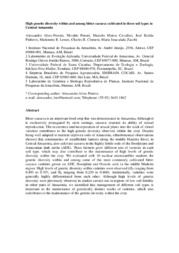High genetic diversity within and among bitter cassava cultivated in three soil types in Central Amazonia.
High genetic diversity within and among bitter cassava cultivated in three soil types in Central Amazonia.
Author(s): ALVES-PEREIRA, A.; PERONI, N.; CAVALLARI, M. M.; PINHEIRO, J. B.; LEMES, M. R.; CLEMENT, C. R.; ZUCCHI, M. I.
Summary: Bitter cassava is an important food crop that was domesticated in Amazonia. Although it is exclusively propagated by stem cuttings, cassava retained its ability of sexual reproduction. The occurrence and incorporation of sexual plants into the stock of clonal varieties contributes to the high genetic diversity observed within the crop. Despite being well adapted to nutrient deprived soils of Amazonia, ethnobotanical observations showed that communities of smallholder farmers along the middle Madeira River, in Central Amazonia, also cultivate cassava in the highly fertile soils of the floodplains and Amazonian dark earths (ADE). These farmers grow different sets of varieties in each soil type, which may also contribute to the maintenance of high levels of genetic diversity within the crop. We evaluated with 10 nuclear microsatellite markers the genetic diversity within and among some of the most commonly cultivated bitter cassava varieties grown on ADE, floodplain and Oxisols soils in the middle Madeira region. High levels of genetic diversity within varieties were observed (HO ranging from 0.495 to 0.707, and HE ranging from 0.250 to 0.460). Additionally, varieties were generally highly differentiated from each other. Although high levels of genetic diversity were previously observed in studies carried out in regions of low soil fertility in other parts of Amazonia, we identified that management of different soil types is important to the maintenance of genetically distinct stocks of varieties, which also contributes to the maintenance of the genetic diversity within the crop.
Publication year: 2014
Types of publication: Abstract in annals or event proceedings
Unit: Embrapa Maranhão
Keywords: Amazonia, Bitter cassava, Cassava, Diversidade genética, Mandioca, Reprodução
Observation
Some of Embrapa's publications are published as ePub files. To read them, use or download one of the following free software options to your computer or mobile device. Android: Google Play Books; IOS: iBooks; Windows and Linux: Calibre.
Access other publications
Access the Agricultural Research Database (BDPA) to consult Embrapa's full library collection and records.
Visit Embrapa Bookstore to purchase books and other publications sold by Embrapa.

